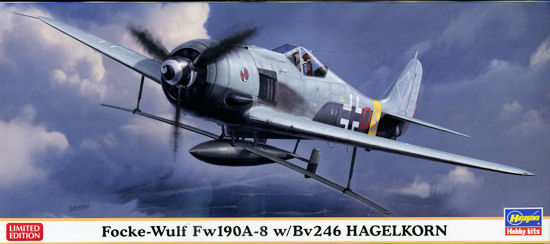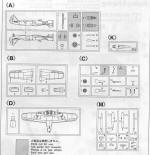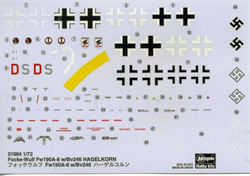
Hasegawa 1/72 FW-190A-8 w Bv-246 "Hagelkorn"
| KIT #: | 01984 |
| PRICE: | 2080 yen (@$26.00) at Hobby Link Japan |
| DECALS: | Two options |
| REVIEWER: | Scott Van Aken |
| NOTES: | Reissue (sort of) |

| HISTORY |
This glider was designed by Dr. Richard Vogt, at first under the designation of BV 226, which was later changed to its definitive designation BV 246 on December 12, 1943.
It was intended to be dropped from a Ju 88 or a Heinkel He 111 bomber, either of which could carry three of the weapons, and was to be dropped from a height of 7,000 m (23,000 ft) at a speed of 550 km/h (340 mph), giving it a range of up to 210 km (130 mi). In a slight dive the Bv 226 could reach a speed of 900 km/h (560 mph).
The construction of the BV 246 was very simple, so it could be mass produced. It had clean aerodynamics, with high aspect ratio wings that made possible a glide ratio of 25:1. The wings were made of concrete, cast around a steel core. It had a cruciform tail in an early version and a double vertical tail mounted on the sides of a wide horizontal stabilizer in a later version. It had a length of 3.53 m (11.6 ft) and a wingspan of 6.4 m (21 ft). Its total weight was 730 kg (1,600 lb), of which 435 kg (960 lb) was the explosive warhead.
Initial tests revealed that the basic design was workable, but that the weapon was very inaccurate and because of the this it was rejected. However, work was restarted in 1943, with 11 different versions being planned, due to its simple and inexpensive construction, and the new development contract was awarded to the Karlshagen test centre. A series of tests was begun to improve the weapon's accuracy, with air drops performed by KG 101. Despite unpromising results, the Ministry of Aviation nevertheless issued the order to commence mass production on 12 December 1943. In February 1944 the contract was cancelled due to the success of the V-1 flying bomb.
The weapon was revived a further time, in early 1945, as an early form of anti-radiation missile, using the Radieschen passive seeker which was designed to home in on Allied radar transmitters; around 1,000 units were produced but never used operationally.
As you can tell from the kit, one was tested for use with a FW-190A-8.
| THE KIT |
 According
to notes in the kit instructions, it was thought originally that the carrier
aircraft was a FW-190A-5. A recently discovered photo proved it was the A-8
version, and since Hasegawa does a nice FW-190A-8, this one was released with
the addition of the glide bomb. Now the wording of the instructions seems to
hint at an earlier release kit with this bomb, but I do not recall that one, and
I collect 1/72 Hasegawa 190 kits.
According
to notes in the kit instructions, it was thought originally that the carrier
aircraft was a FW-190A-5. A recently discovered photo proved it was the A-8
version, and since Hasegawa does a nice FW-190A-8, this one was released with
the addition of the glide bomb. Now the wording of the instructions seems to
hint at an earlier release kit with this bomb, but I do not recall that one, and
I collect 1/72 Hasegawa 190 kits.
Regardless, what you get in the box is an old friend to many. The molds have held up well with only a tiny bit of flash on a part or two. As usual, a replacement cockpit or at least some belts would be handy, though there is little to be seen through the small opening. Decals are used for the instrument panel and side consoles, which for most of us is just fine. There are some bits to be filled in such as the wing gun openings and a few holes to be opened in the lower wing for the mounting of the rack and braces for the 246. The kit only comes with the early style canopy and there are some parts that will not be needed for this build (like the drop tank and rack).
 There is a
new sprue for the Bv-246 and while I thought it might be the same as came with
an old Condor weapons set, it appears to be one done by Hasegawa.
There is a
new sprue for the Bv-246 and while I thought it might be the same as came with
an old Condor weapons set, it appears to be one done by Hasegawa.
Markings are for several aircraft. The lone test aircraft was standard FW-190 with no distinguishing markings. So Hasegawa provided a 'what if' set of markings. This set is shown on the box art as being with KG 53 and has a black underside with yellow tail band and bomber codes. The decal sheet offers alternate styles of swastika for the fin and a couple of other unit badges that I could not immediately identify. It would have been nice to have the later 'blown' canopy provided as if this weapon would have been used late in the war by the 190, those airframes would have probably had the later canopy. The decal sheet is nicely printed and like most modern Hasegawa decal sheets should prove to have no issues.
| CONCLUSIONS |
As with the armor folks getting more and more esoteric, so it is with Hasegawa and their WWII aircraft kits. Their 190 series in this scale is now into the near 3 dozen realm so it will be interesting to see what they come up with next. If you like to model a bit off the beaten track, this is one for you.
| REFERENCES |
http://en.wikipedia.org/wiki/BV_246
August 2012
Thanks to Hobby Link Japan for the preview kit. You can get this kit today at the link.
If you would like your product reviewed fairly and fairly quickly, please contact the editor or see other details in the Note to Contributors.